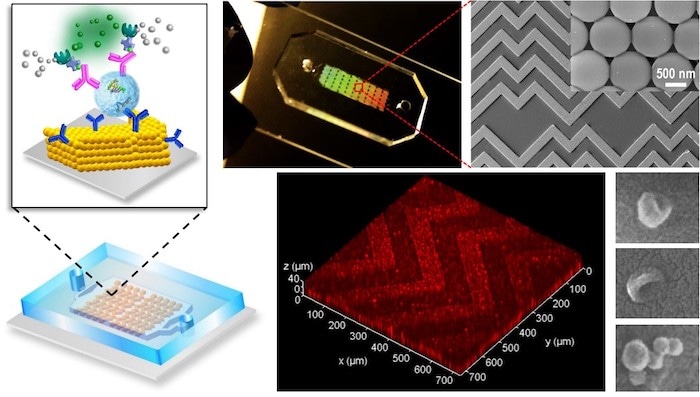Feb 26 2019
A research team, at the University of Kansas (KU), KU Medical Center, and The University of Kansas Cancer Center, developed a novel ultrasensitive diagnostic device that could enable physicians to rapidly detect cancer from a droplet of plasma or blood. This latest breakthrough paves the way for timelier interventions as well as improved outcomes for patients.
 The new lab-on-a-chip’s key innovation is a 3D nanoengineering method that mixes and senses biological elements based on a herringbone pattern commonly found in nature, pushing exosomes into contact with the chip’s sensing surface much more efficiently in a process called “mass transfer.” (Image credit: Yong Zeng)
The new lab-on-a-chip’s key innovation is a 3D nanoengineering method that mixes and senses biological elements based on a herringbone pattern commonly found in nature, pushing exosomes into contact with the chip’s sensing surface much more efficiently in a process called “mass transfer.” (Image credit: Yong Zeng)
Reported in Nature Biomedical, the “lab-on-a-chip” for “liquid biopsy” analysis is capable of detecting exosomes, which are very small parcels of biological information created by tumor cells to trigger tumor metastasis or tumor growth.
Historically, people thought exosomes were like ‘trash bags’ that cells could use to dump unwanted cellular contents. But in the past decade, scientists realized they were quite useful for sending messages to recipient cells and communicating molecular information important in many biological functions. Basically, tumors send out exosomes packaging active molecules that mirror the biological features of the parental cells. While all cells produce exosomes, tumor cells are really active compared to normal cells.
Yong Zeng, Study Lead Author, Docking Family Scholar, and Associate Professor, Department of Chemistry, University of Kansas
The key innovation of the novel lab-on-a-chip is a 3D nanoengineering technique that combines and perceives biological elements predicated on a herringbone pattern often found in nature, forcing exosomes to come into contact with the sensing surface of the chip in a much more efficient way in a process known as “mass transfer.”
People have developed smart ideas to improve mass transfer in microscale channels, but when particles are moving closer to the sensor surface, they’re separated by a small gap of liquid that creates increasing hydrodynamic resistance. Here, we developed a 3D nanoporous herringbone structure that can drain the liquid in that gap to bring the particles in hard contact with the surface where probes can recognize and capture them.
Yong Zeng, Study Lead Author, Docking Family Scholar, and Associate Professor, Department of Chemistry, University of Kansas
Zeng compared the nanopores of the chip to a countless number of tiny kitchen sinks: “If you have a sink filled with water and many balls floating on the surface, how do you get all the balls in contact with the bottom of the sink where sensors could analyze them? The easiest way is to drain the water.”
In order to create and test the groundbreaking microfluidic device, Zeng partnered with KU Cancer Center Deputy Director and a tumor-biomarker expert Andrew Godwin from the Department of Pathology & Laboratory Medicine at the KU Medical Center, and Ashley Tetlow, a graduate student in Godwin’s Biomarker Discovery Lab. Using clinical samples obtained from ovarian cancer patients, the collaborative team tested the design of the chip and eventually discovered that the chip can potentially identify the presence of cancer in just a small amount of plasma.
“Our collaborative studies continue to bear fruit and advance an area crucial in cancer research and patient care—namely, innovative tools for early detection,” stated Godwin, who serves as Chancellor’s Distinguished Chair and Endowed Professor in Biomedical Sciences and professor and director of molecular oncology, pathology, and laboratory medicine at KU Medical Center. “This area of study is especially important for cancers such as ovarian, given the vast majority of women are diagnosed at an advanced stage when, sadly, the disease is for the most part incurable.”
In addition, the KU-developed microfluidic chips that would be easier and cheaper to develop when compared to similar designs, thus enabling broader and cost-effective testing for patients.
“What we created here is a 3D nanopatterning method without the need for any fancy nanofabrication equipment—an undergraduate or even a high school student can do it in my lab,” stated Zeng. “This is so simple and low-cost it has great potential to translate into clinical settings. We’ve been collaborating with Dr. Godwin and other research labs at The KU Cancer Center and the molecular biosciences department to further explore the translational applications of the technology.”
Now, with the recently proven design of the microfluidic chip using ovarian cancer as a model, the chip can potentially help in detecting various other diseases, added Zeng.
“Now, we’re looking at cell-culture models, animal models, and also clinical patient samples, so we are truly doing some translational research to move the device from the lab setting to more clinical applications,” he stated. “Almost all mammalian cells release exosomes, so the application is not just limited to ovarian cancer or any one type of cancer. We’re working with people to look at neurodegenerative diseases, breast and colorectal cancers, for example.”
On KU’s Lawrence campus, Zeng collaborated with a team that included Peng Zhang, postdoctoral fellow; Xin Zhou, a graduate student in the Department of Chemistry; and also Mei He, KU assistant professor of chemistry and chemical engineering.
The study was supported by grants from National Institutes of Health, including a joint R21 (CA1806846) and a R33 (CA214333) grant between Godwin and Zeng and the KU Cancer Center’s Biospecimen Repository Core Facility, partly funded by a National Cancer Institute Cancer Center Support Grant (P30 CA168524).